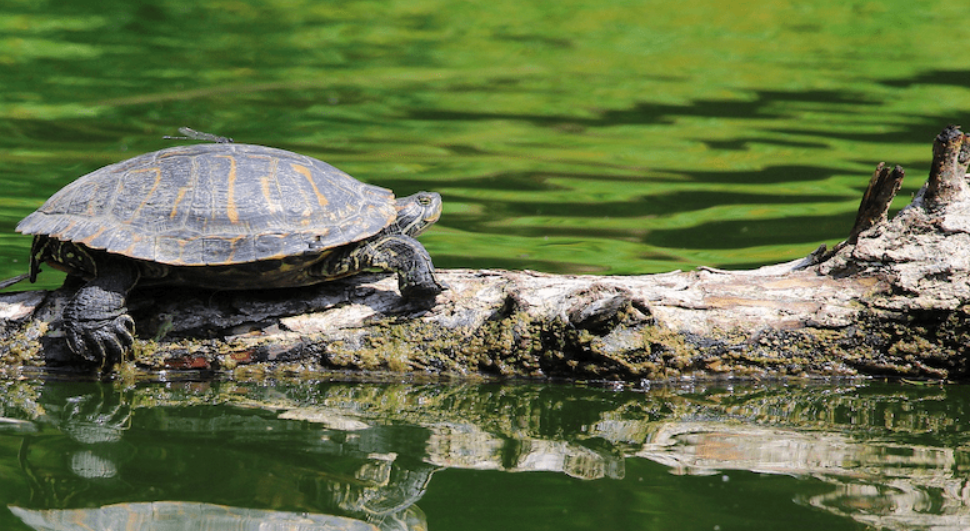
Study Shows How Turtles Fared a Decade After Oil Spill
Ashton RouthierShare
Overview
Twelve years after a devastating oil spill coated nearly 35 miles of the Kalamazoo River, new research from the University of Toledo has provided hopeful news for the wildlife affected by the disaster. The study confirms that turtles rehabilitated in the aftermath of the spill have exhibited high long-term survival rates, showcasing the success of rehabilitation efforts and the resilience of these animals.

New Research Highlights Long-Term Survival of Rehabilitated Turtles
Date: September 27, 2022
Source: University of Toledo
Twelve years after a devastating oil spill coated nearly 35 miles of the Kalamazoo River, new research from the University of Toledo has provided hopeful news for the wildlife affected by the disaster. The study confirms that turtles rehabilitated in the aftermath of the spill have exhibited high long-term survival rates, showcasing the success of rehabilitation efforts and the resilience of these animals.
The Kalamazoo River Oil Spill: A Recap
The Incident
In July 2010, a pipeline rupture released over a million gallons of crude oil into the Kalamazoo River, causing widespread environmental damage. This catastrophic event marked one of the largest inland oil spills in U.S. history. The spill affected a significant stretch of the river, spanning over 35 miles and contaminating the water and surrounding soil. The thick, heavy crude oil seeped into the riverbed and banks, creating a persistent pollution problem that proved challenging to remediate.
The environmental impact was profound. The contamination disrupted the delicate ecosystem of the Kalamazoo River, severely affecting local wildlife. A large population of turtles was among the most visibly impacted; many were found covered in oil, struggling to breathe and move. These turtles required extensive rehabilitation efforts, including cleaning and medical treatment, to survive. Other wildlife, such as fish, birds, and small mammals, also suffered, with many found dead or in distress due to oil exposure.
Immediate Response
In response to the spill, extensive cleanup and wildlife rescue operations were launched, mobilizing a coordinated effort among environmental agencies, non-profit organizations, and local volunteers. Teams worked tirelessly to contain and remove the spilled oil from affected areas, using a variety of methods including skimming, booms, and absorbent materials to minimize environmental damage.
Particular attention was given to wildlife rescue, with specialized teams focusing on the recovery and care of affected animals. Turtles, being particularly vulnerable due to their tendency to ingest or become coated with oil, were a primary concern. These turtles were collected from the contaminated areas and transported to rehabilitation centers where they underwent thorough cleaning to remove the oil from their shells and bodies. This process often involved multiple stages of washing with gentle, non-toxic detergents to ensure all residues were eliminated without causing additional stress or harm to the turtles.
The Study's Key Findings
The University of Toledo's research, conducted over a decade, focused on the long-term survival and health of rehabilitated turtles following the Kalamazoo River oil spill. Key findings from the study include that rehabilitated turtles had a high survival rate, comparable to non-affected populations. The turtles displayed normal health indicators and reproductive behaviors, suggesting successful reintegration into their natural habitat. Using tracking devices, researchers monitored the movement and behavior of the turtles, confirming their adaptability and resilience in the post-spill environment. The study underscores the resilience of turtles and their ability to adapt to restored environments following rehabilitation, highlighting the importance of wildlife rescue and rehabilitation programs in mitigating the long-term impacts of environmental disasters.
Implications for Future Wildlife Rehabilitation
The success of the rehabilitation efforts following the Kalamazoo River oil spill provides valuable insights into best practices for future wildlife rescue operations. These best practices include comprehensive care, which involves thorough cleaning, medical treatment, and ongoing monitoring of affected wildlife; habitat restoration, which focuses on restoring contaminated habitats to support the reintegration of rehabilitated animals; and community involvement, which engages local communities in rehabilitation efforts to enhance awareness and support for conservation initiatives.
Importance of Long-Term Monitoring
The study emphasizes the need for long-term monitoring to assess the effectiveness of rehabilitation efforts. It highlights that simply rescuing and rehabilitating wildlife in the immediate aftermath of an oil spill is not enough to ensure their long-term survival and well-being. Continued tracking and health assessments are crucial for understanding the full impact of environmental disasters on wildlife populations.
Long-term monitoring involves fitting rehabilitated animals with tracking devices to observe their movements, behaviors, and survival rates once they are released back into their natural habitats. This data is invaluable for identifying any ongoing health issues or behavioral changes that might indicate lingering effects of the spill. Health assessments conducted at regular intervals can help detect chronic conditions, reproductive success, and overall fitness, providing a comprehensive picture of the animal's recovery.
The Role of Research and Conservation
Research conducted by institutions like the University of Toledo plays a critical role in advancing our understanding of wildlife resilience and the effectiveness of rehabilitation programs, contributing to the development of better conservation practices and policies. The findings from this study highlight the importance of supporting and funding wildlife rehabilitation and conservation programs, which are essential for protecting biodiversity and ensuring the survival of species affected by environmental disasters.
source: https://www.sciencedaily.com/releases/2022/09/220927102327.htm